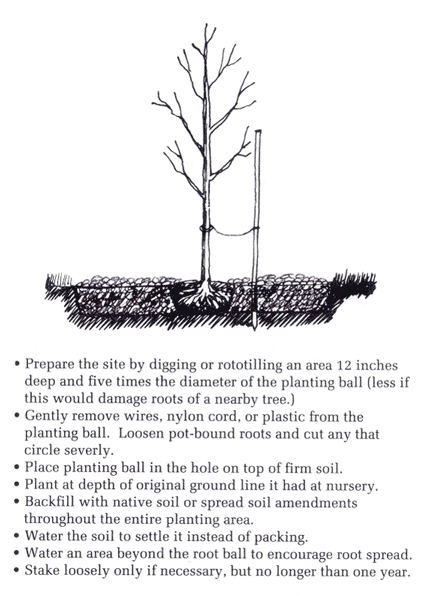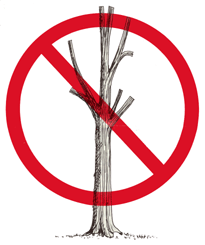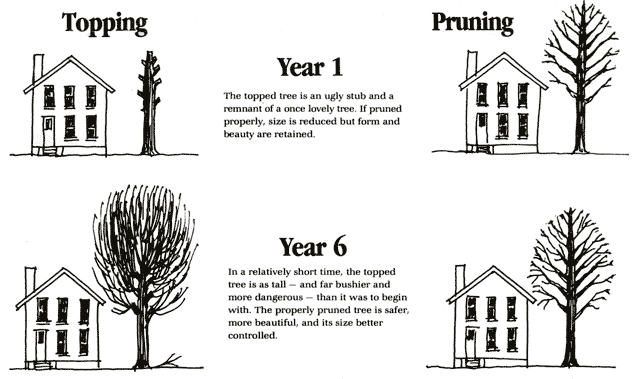Common Myths About Trees
Research shows that some of the “old” methods of caring for trees are no longer acceptable. Dr. Alex Shigo, and others, have found that the following practices or beliefs are not true. The Myths listed below are common misconceptions, misunderstandings and half-truths relating to proper tree care. Many of these myths are still practiced, mostly because people don’t know about new research findings. There are many other “Myths” concerning trees that can mean the difference between a beautiful, healthy tree or one that is just surviving. Check the Coeur d’Alene Public Library for a copy of 100 Tree Myths by Alex L. Shigo.
Myth 1: Anyone can plant a tree correctly!
Many people purchase and plant a tree then forget about it. A lot of thought needs to go into first choosing the right tree for the right spot, then properly planting and caring for it afterwards. Trees are perishable products and must be treated accordingly. For additional information about planting trees, you can go to Planting and Parenting.
Myth 2: Lots of mulch is good.
While a 3 to 4 inch layer of mulch can be beneficial, excessive amounts of mulch may disrupt soil moisture and aeration. Also be careful to keep mulch away from the trunk of the tree. It can allow pathogens to cause crown rot at the base of the tree. It is best to keep adding small amounts of composted material over time, tapering the depth of the mulch as it gets close to the tree trunk.
Myth 3. Lots of soil amendments are good in the planting site.
Do not amend the planting site when the soil is good. Different soils and compost materials act differently, especially in relation to moisture and nutrient availability. If the soil is amended when planting, there is the risk that the trees roots will not venture out into the native soil, thus reducing the its’ root system. Changes in soil types can also affect soil drainage, and trees can be drowned, or moisture-starved. If very poor soil demands the addition of amendments, work in the soil amendments over a very large area.
Myth 4. Topping is more than an assault on beauty.
It not only injures wood in the crown, but injures roots as well. Topping can remove too much of a tree’s canopy and thereby cause the tree to go into shock. The large stubs invite the entry of insects and diseases. The rapid new growth, a panic reaction of the tree, is thick and weakly attached. Often this wild growth makes the tree even larger than it was before topping. Topping can kill some trees. A topped tree is a disfigured tree that never regains its former grace and character. Topping may cost less in the short run, but the true costs of topping are hidden.

Myth 5. Do not prune trees that “Bleed” in spring.
When to prune depends on why you prune. Light pruning and removal of dead wood can be done anytime. Some species, such as maples, walnuts and birches, may “bleed” when the sap is flowing in the spring. This is not harmful and will cease when the tree leafs out. When pruning cuts are made correctly, the timing can be extended greatly.
Myth 6. Fertilizers stimulate root growth.
This is a half-truth. Fertilizers, especially nitrogen, do stimulate growth of non-woody roots and short woody roots, but not long woody roots. The same situation occurs where roots are growing in “rich soils”. Treatments that reduce growth of long roots can lead to hazardous trees because of weak mechanical support. Mature trees growing satisfactorily may not need fertilizer.
Myth 7. Fertilizer is tree food.
This is a half-truth. Many people believe that fertilizers provide trees with an energy source. Unlike animals, trees are able to trap the energy of the sun in a molecule called glucose. This is the essential energy source of a tree. From the soil, trees obtain water and 14 elements that are essential for life. The soil elements are absorbed as ions and do not provide an energy source for the trees. If a tree is growing poorly, a soil analysis could be helpful.
Over-fertilizing your tree often over-stimulates crown growth, making it harder for the tree to survive drought.
Myth 8. Injections and implants do not injure trees.
Injections and implants repeated many times can cause serious injuries to trees. Often it is the material more than the wound that causes injury. Technique is also important. Repeated use can cause wounds to “coalesce” or fuse. It is not recommended for routine use.
Myth 9. Before planting, prune living branches to balance crown with roots.
Removing living branches takes food from the tree. A tree will need its foliage to gather energy from the sun. Twigs, branches, and trunks of trees have billions of living cells that store energy reserves. Wait until the branches die, then remove them correctly. Do remove dead and injured branches at planting time.
Myth 10. Wound dressings stop rot.
Wound dressings were once thought to accelerate wound closure, protect against insects and diseases, and reduce decay. However, research has shown that dressings do not reduce decay or prevent insect or disease penetration. Purchasing a special tree wound dressing is waste of money unless it is done for cosmetic purposes only. Using whatever paint is in the garage for cosmetic purposes can actually be detrimental to tree health.








